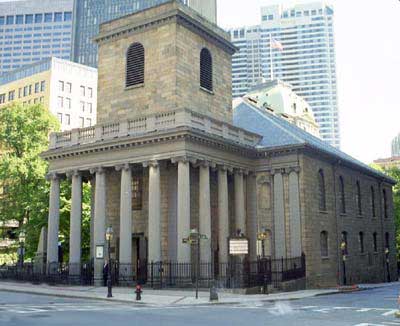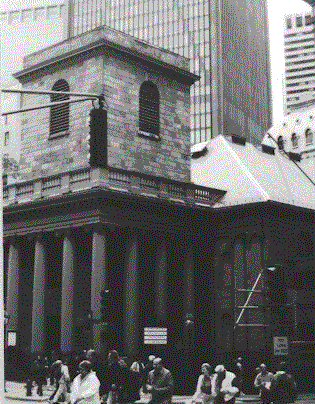
| 
King's Chapel
Peter Harrison, 1754
 The original King's Chapel was a wooden chapel built in 1688
on Puritan burial land seized by Governor Andros. This growing congregation
of mainly loyalists grew and created the need for an additional church,
resulting in the building of Christ
Chapel built in 1723.
The original King's Chapel was a wooden chapel built in 1688
on Puritan burial land seized by Governor Andros. This growing congregation
of mainly loyalists grew and created the need for an additional church,
resulting in the building of Christ
Chapel built in 1723.
Unusual Construction -
To minimize any disruption of worship, the current King's Chapel was built
up as a shell surrounding its wooden predecessor. Pieces of the wooden chapel
were hauled through the completed new churches windows. This larger chapel
required additional land, and resulted in the displacement of the Boston
Latin School, which the congregation paid to reestablish.
The project was substantially underwritten by Charles Bulfinch's grandfather,
who sought to strengthen ties with England. Peter Harrison prepared plans
at no charge, and later was granted a title as a crowned official in Rhode
Island. There he designed various public and private buildings, including
Newport's Touro
Synagogue (1759-1763) . As the revolution took shape, he would also
have his home ruined by the local version of the Son's of Liberty.
Why No Steeple?
The congregation and Harrison intended to adorn the structure with an elaborate
steeple, which was omitted due to funding short falls. Absent a grand steeple,
the most prominent feature is the chapel's substantial colonnade with its
massive Ionic columns. They are flanked by two stories of arched windows,
and focuses in on a fan shaped Paladin window above the chancel.
Like King's Chapel, Harrison's Christ Chapel (1760) just north of Harvard
Square, Cambridge also has a square tower, and is made of wood.
King's Chapel was Boston's first granite structure and was built from surface
granite taken from Quincy Quarry. Colonists laboriously mined the granite
by heating it, and then breaking it into chunks by dropping cannon balls
on it. The exterior is relatively free of ornamental carving, which may
be as much a function of a lack of stone cutters in the new world as it
was of colonial restraint.
Changing the name -
The chapel is named after King James II. Its wooden predecessor was briefly
renamed Queen's Chapel during the 1702-1714 reign
of Queen Ann. As Bostonians generally reviled the King after the revolution,
the chapel was less offensively renamed, Stone Chapel. It was eventually
renamed King's Chapel by the Unitarian Universalist movement in 1789 which
held its first services here. Though spectacular inside, encroachment from
the city around makes it seem trapped between city streets which grew up
around it.
|
|
| INTRODUCING |
|
From the writers of iBoston.org |
|
|
|



